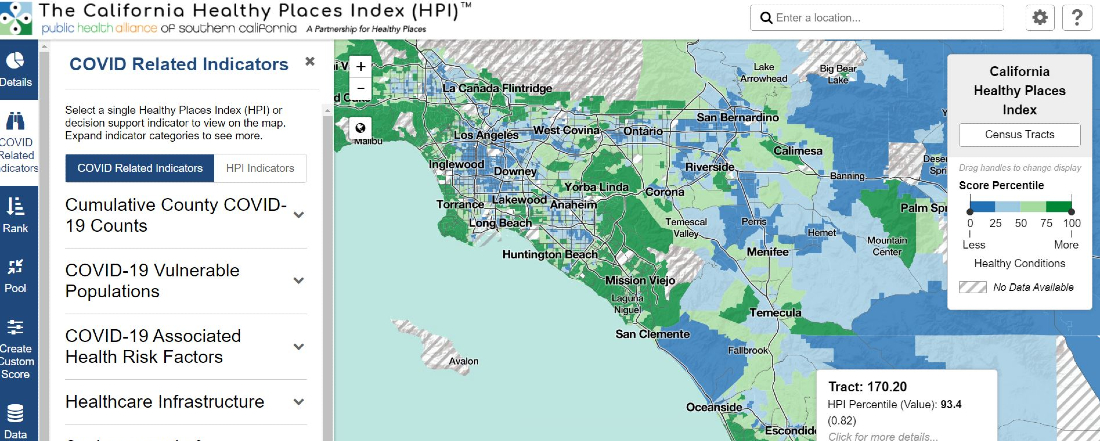
In the News
What California’s New Equity Rule Means for Economic Reopening
- Politico
-
Focus Areas
Communicable Disease Prevention, Healthy Communities -
Issues
Population Health -
Expertise
Public Policy Development, Public-Private Partnerships -
Programs
Healthy Places Index (HPI), Public Health Alliance of Southern California -
Strategic Initiatives
COVID-19

California has launched the nation’s first mandate on reopening that requires local officials to control the coronavirus in their most impoverished communities before easing business restrictions across their entire county.
The approach is aimed at tackling a persistent inequity in California, where low-income people of color have disproportionately struggled to avoid contracting the disease.
The COVID-19 pandemic has laid stark the health disparities that have long existed, with poor, Black, Latino, Pacific Islander and Native communities being hardest hit by the pandemic. Latinos, for example, make up about 40 percent of the state’s population, but account for more than 60 percent of coronavirus cases and half the deaths.
California’s “equity metric” attempts to tackle that disparity by requiring that the 35 largest counties invest more in testing and ensure that positive rates of infection in the most disadvantaged neighborhoods come close to meeting the county’s overall positivity rate. The rule ensures that restaurants in Beverly Hills can’t resume indoor dining unless the most impoverished census tracts also show low rates of infection.
The equity move could prompt counties to expand testing in low-income neighborhoods and provide tests to anyone who fears they have been exposed, not just those who show symptoms. That may allow such communities to more quickly isolate patients, especially those who are asymptomatic.
The metric uses the California Healthy Places Index to identify the lowest, most disadvantaged quartile in the larger counties’ census tracts. The smallest 23 counties are exempt — with populations of 106,000 or below — but still have to provide the state with an equity plan for their most vulnerable populations.
Los Angeles County Public Health Officer Barbara Ferrer said that the new metric may actually help advance the state’s largest county, which has stubbornly remained in the purple tier due to high case counts.
That’s because the equity rule has a wrinkle that rewards counties that dramatically lower their positive test rates overall and in low socioeconomic neighborhoods. If a county can drive down those positivity rates to levels two tiers below, it can move forward one tier. The caveat is that case rates still have to be going down, not up.
“All of the work that everyone is doing so hard to really focus on the disproportionality and eliminate it, I think is helping us both to reduce transmission but, in this case, also offers us the ability to move to another tier,” Ferrer said during a press briefing Monday.
Humboldt County was the first county allowed to advance on the basis of low positivity rates both overall and in their lowest quartile communities. It moved to the yellow tier Tuesday despite a case rate hovering just outside the yellow threshold.
The potential benefit of the new metric is no surprise to Kiran Savage-Sangwan, executive director of the California Pan-Ethnic Health Network. She said the metric is designed to encourage more testing.
“I don’t think anyone will be hurt by this metric. Really it’s going to help us better control the spread of the virus,” she said. “By putting the focus of the resources and investments where they needed to be, it is benefiting the counties.”
Read the full article in Politico.
Read the PHI statement: California to Use PHI’s HPI Tool in Creating COVID Equity Metric
Other recent news coverage includes:
Los Angeles Times, California adds COVID-19 equity requirement. It could trip up counties’ reopenings
Orange County Register, New health equity metric will help decide counties’ tier in pandemic tracking system
San Diego Union Tribune, San Diego County remains in red tier
San Jose Mercury News, Coronavirus: What does California’s new “equity” metric mean for the Bay Area?
East Bay Times, Coronavirus tracker: Here’s where every California county stands in the state’s tier system on Oct. 6
CBS San Diego, California launches new ‘health equity metric’ focused on disparities of COVID-19 impact
Originally published by Politico
More Updates
Work With Us
You change the world. We do the rest. Explore fiscal sponsorship at PHI.
Support Us
Together, we can accelerate our response to public health’s most critical issues.
Find Employment
Begin your career at the Public Health Institute.



